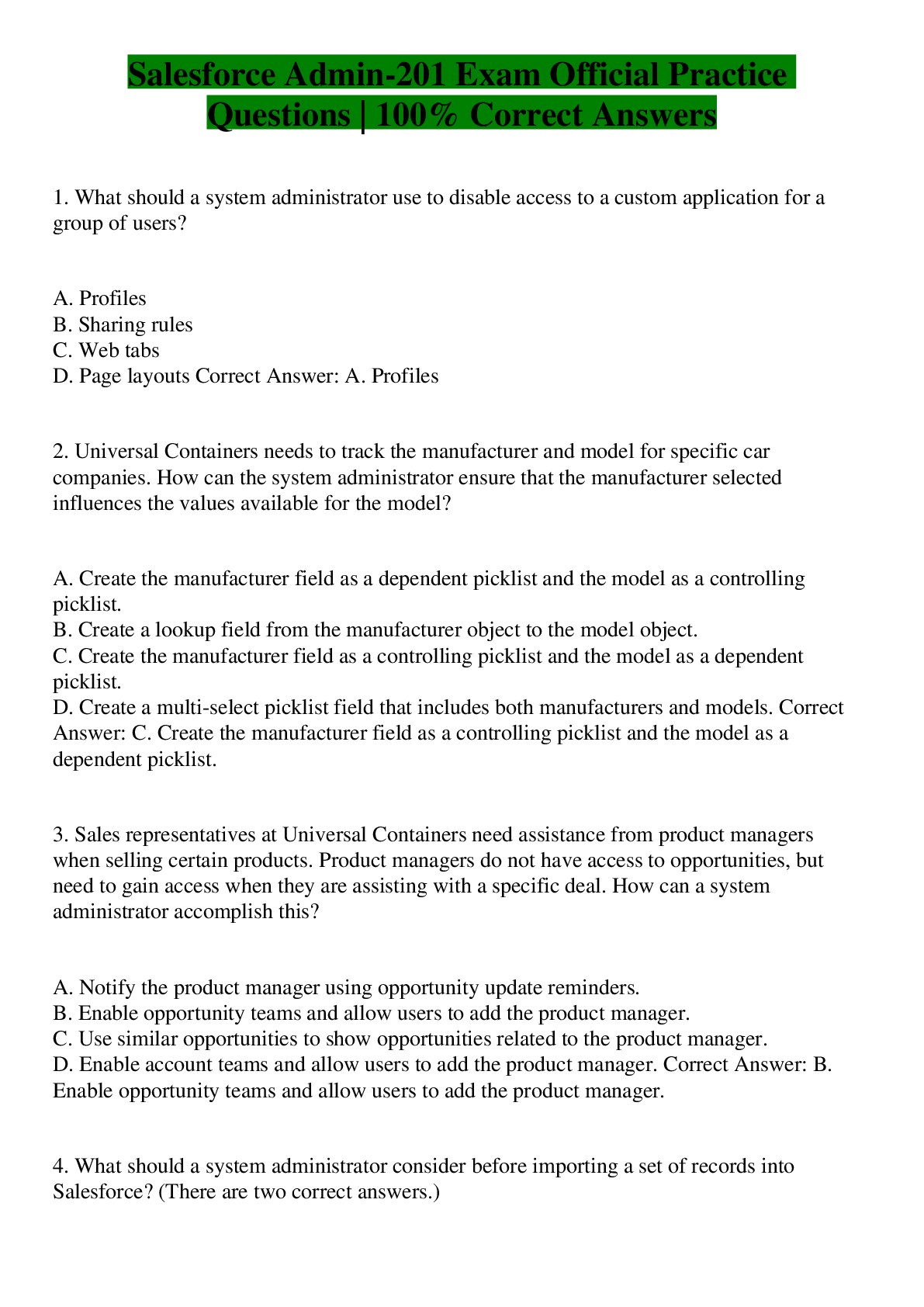Pathophysiology > QUESTIONS & ANSWERS > Neurology 50 Practice Questions with Answers. (All answers explained) (All)
Neurology 50 Practice Questions with Answers. (All answers explained)
Document Content and Description Below
All answers explained at the document end 1.Activation of a postsynaptic acetyl choline receptors results in which of the following? a.An efflux of Na+ into the cell and an efflux of K+, depolarizin... g the postsynaptic neuron b.An influx of Na+ into the cell and an efflux of K+, depolarizing the postsynaptic neuron c.An influx of Na+ into the cell and an influx of K+, depolarizing the postsynaptic neuron d.An influx of Na+ into the cell and an efflux of K+, repolarizing the postsynaptic neuron e.An efflux of Na+ into the cell and an influx of K+, repolarizing the postsynaptic neuron 2.Atropine and scopolamine a.block ACh actions only at muscarinic receptors. b.inhibit the release of AChr. c.prevent Ach receptor channel opening. d.prevent Ach receptor channel opening at motor end plate. e.block presymptomatic vesicle mobility. 3.Of the four main dopaminergic tracts, the a.nigrostriatal tract accounts for only a small part of the brain’s dopamine. b.tuberoinfundibular tract controls release of prolactin via D3 receptors. c.tuberoinfundibular tract controls release of prolactin via D2 receptors. d.mesolimbic tract controls release of prolactin via D3 receptors. e.mesocortical tract controls release of prolactin via D2 receptors. 4.Raphe nuclei a.project rostrally, mainly in the medulla and spinal cord. b.project caudally to the limbic structures and the cerebral cortex. c.project caudally, mainly to the medulla and spinal cord. d.stimulation produces effects similar to those of glutamate. e.lie dorsally in the diencephalon. 5.Which of the following is true regarding Prader-Willi syndrome and Angelman’s syndrome? a.Prader-Willi syndrome is paternally inherited with maternal imprinting; Angelman’s syndrome is paternally inherited with maternal imprinting. b.Prader-Willi syndrome is maternally inherited with maternal imprinting; Angelman’s syndrome is paternally inherited with paternal imprinting. c.Prader-Willi syndrome is maternally inherited with paternal imprinting: Angelman’s syndrome is paternally inherited with maternal imprinting. d.Prader-Willi syndrome is paternally inherited with maternal imprinting; Angelman’s syndrome is maternally inherited with paternal imprinting. e.In both Prader-Willi syndrome and Angelman’s syndrome, genes inherited from the father are silenced via methylation. 6.Trinucleotide repeats are seen in which of the following genetic conditions? a.Alzheimer’s disease; fragile X; Huntington’s disease b.Friedreich’s ataxia; AR torsion dystonia; myotonic dystrophy c.FTD; Segawa syndrome; fragile X d.Myotonic dystrophy; adult-onset focal dystonia; Alzheimer’s disease e.Fragile X; myotonic dystrophy; Friedreich’s ataxia 7.Which of the following clinical syndromes is matched with the appropriate region of protein/gene abnormality? a.Kallmann’s anosmia-hypogonadism: ATP-binding cassette transporter 7(ABCB7) b.Rett syndrome: cyclin-dependent kinase-like 5 (CDKL5) c.LIS1: reelin (RELN) d.LISX1: alpha-1-tubulin (TUBA1A) e.Holoprosencephaly: sonic hedgehog (SHH) 8.Which of the following statements related to disorders of primary neurulation is (are) correct? a.Spina bifida results from failure of the anterior neuropore to form. b.Spina bifida aperta is associated with a neurological deficit in 90% of those affected. c.Meningocele is a herniation of a cerebrospinal-fluid-filled sac with neural elements. d.Meningocele is a herniation of a cerebrospinal-fluid-filled sac without neural elements. e.B and D f.A, B, and C 9.Dandy-Walker syndrome is characterized by which of the following? a.Failure of foramen Magendie development; enlarged cerebellar vermis; agenesis of the corpus callosum b.Depression of the inion; cardiac abnormalities; increased migrational disorders c.Failure of foramen of Magendie development; cystic dilation of 4th ventricle; cerebellar vermis agenesis with enlarged posterior fossa d.Holoprosencephaly; elevation of the inion; agenesis of corpus callosum e.Absent septum pellucidum; hypoplastic optic nerves: schizencephaly 10.The shaded area represents which brain area? a.Somatosensory association cortex b.Parahippocampal gyrus c.Hippocampal gyrus d.Prefrontal cortex e.Limbic system 11.Which of the following thalamic nuclei is matched with the appropriate inputs and projections? a.Anterior: mammillary nucleus of the hypothalamus; cingulate gyrus b.Anterior: globus pallidus; striatum c.Pulvinar: association areas; striatum d.Ventroposterolateral: trigeminothalamic tracts; sensory cortex e.Lateral geniculate body: auditory input; primary auditory cortex 12.Which of the following superior-division middle cerebral artery branches is matched to the correct clinical syndrome? a.Ascending frontal branch: brachial monoplegia b.Ascending parietal: conduction aphasia c.Cortical-subcortical: brachial monoplegia d.Rolandic: primarily cortical sensory deficit e.Ascending parietal: agrammatic speech with normal comprehension 13.Which aphasia type is matched with the correct characteristics of comprehension, fluency, repetition, and naming? a.Transcortical sensory: spared comprehension, normal fluency, normal repetition, impaired naming b.Global aphasia: impaired comprehension, impaired fluency, spared repetition, impaired naming c.Broca: impaired comprehension, impaired fluency, impaired repetition, impaired naming d.Transcortical motor: spared comprehension, impaired fluency, normal repetition, impaired naming e.Conduction: spared comprehension, impaired fluency, normal repetition, impaired naming 14.Balint’s syndrome of oculomotor apraxia, optic ataxia, and asimultagnosia can be due to a.bilateral mesial frontal infarction. b.mesial hippocampal infarction. c.lateral temporal infarction. d.infarction of Striae of Gennari. e.bilateral occipito-parietal infarctions. 15.Contralateral paralysis of the arm and leg, contralateral impaired tactile and proprioceptive sense, and ipsilateral tongue paralysis are seen in which of the following syndromes? a.Posterior medullary region b.Avellis syndrome c.Wallenberg syndrome d.Jackson syndrome e.Medial medullary syndrome 16.IV thrombolysis with tissue plasminogen activator is approved by the FDA for which of the following? a.Ischemic stroke presenting within 4.5 hours b.Ischemic stroke presenting within 3 hours c.Hemorrhagic stroke presenting within 3 hours d.TIA presenting within 3 hours e.Lacunar stroke presenting within 3 hours 17.Concussion is defined as a.bruising of the brain without interruption of its architecture. b.contre-coup injury. c.violent shaking or jarring of the brain with transient functional impairment. d.head injury with definite loss of consciousness. e.focal injury at the site of impact. 18.Which of the following statements is correct regarding minor head injury? a.CT imaging is mandatory with minor head injury. b.All minor head injuries should be evaluated by a neurologist. c.There is a 1-in-1,000 chance of intracranial hemorrhage if no fracture and mentally clear. d.There is a 1-in-500 chance of intracranial hemorrhage if no fracture and mentally clear. e.There is a 1-in-100 chance of intracranial hemorrhage if no fracture and mentally clear. 19.Chronic subdural hematomas a.occur after a lucid period. b.generally occur weeks after a well-defined head injury. c.can cause aphasia as a common presentation. d.require immediate burr-hole evacuation. e.may be accompanied by giddiness, slowness of thinking, confusion, or apathy. 20.Which of the following is correct regarding treatment of refractory hypertension in the neurological ICU? a.Blood pressure should be reduced if SBP >185, regardless of baseline blood pressure. b.Nitroprusside is an acceptable treatment for hypertension in this setting. c.Nicardipine, hydralazine, or labetalol is recommended for the NICU setting. d.Aim is to keep MAP <90. e.Aim is to keep MAP <110. 21.Which of the following is true regarding intracranial hematoma expansion? a.It does not occur after first presentation except in rare circumstances. b.It is less likely in poorly controlled diabetics c.Patients may show the “spot sign.” d.Patients may show the “dot sign.” e.Antiplatelets increase the risk for ICH expansion. 22.Mild cognitive impairment (MCI) differs from dementia in that a.language disorders are uncommon in MCI. b.activities of daily living are generally spared. c.patient retains insight into problems with memory. d.MRI imaging differs between MCI and dementia. e.α beta 42 CSF levels are normal in MCI. 23.Alzheimer’s disease is a.more likely with higher education. b.more likely with moderate drinking. c.more likely with apolipoprotein E2 allele. d.less common with Down syndrome. e.more common with midlife obesity. 24.Which of the following is true regarding Lewy body disease (LBD) pathology? a.It consists of amyloid deposition in the striata nigra. b.Patient has antibodies against ubiquitin or alpha-synuclein. c.It never occurs with Alzheimer’s pathology. d.Patient has Lewy bodies (intracellular eosinophilic core with peripheral halo). e.Defects in NMDA have been described in LBD. 25.Frontotemporal dementia can present with which of the following? a.Semantic dementia; apathy; nonfluent aphasia b.ALS and behavioral disorders; cortical blindness; ataxia c.Nonfluent aphasia; memory disorder; myoclonic seizures d.Diffuse myoclonus; logopenic aphasia; simultanagnosia e.Depression; apraxia for limb kinetic activities; abulia 26.Migraine without aura includes a.headache attacks lasting 1 to 3 hours. b.improvement with exercise. c.bilateral temporal distribution. d.pulsatile quality. e.mild pain intensity. 27.A 54-year-old male patient comes to your practice. He has recurrent unilateral supraorbital attacks of pain lasting 2 minutes. These occur from 5 to 25 times a day. During the pain, he notices he has increased tearing. He has had these attacks for the past year and has had a workup for mass lesions, which was negative. You diagnose which of the following? a.Temporal arteritis b.Paroxysmal hemicranias c.Migraine with autonomic features d.Secondary headache due to undiagnosed orbital pseudotumor e.SUNCT 28.Which of the following is the most appropriate match between muscle fiber type and characteristics? a.Type 1: tonic; dark color; small fiber diameter; slow twitch speed; low fatigability b.Type 1: phasic; dark color; small fiber diameter; fast twitch speed; low fatigability c.Type 2a: phasic; pale color; largest fiber diameter; fast twitch speed; low fatigability d.Type 2b: Tonic; dark color; small fiber diameter; slow twitch speed; low fatigability e.Type 2b; Phasic; pale color; largest fiber diameter; slow twitch speed; high fatigability 29.In differentiating a peroneal nerve lesion from an L5 root lesion, which of the following signs is most useful? a.Knee flexion weakness b.Knee extension weakness c.Foot everter weakness d.Intrinsic foot muscle weakness e.Foot inverter weakness 30.Meralgia paresthetica a.is a psychiatric dissociation disorder. b.was described by Karl Jung. c.is due to entrapment of the lateral femoral cutaneous nerve. d.can be reliably diagnosed by electrophysiology. e.is usually treated surgically. 31.A 15-year-old boy comes into your clinic with his mother. He had an early morning generalized tonic-clonic seizure 2 weeks ago and is now on phenytoin 100 mg three times a day. His mother notes that in the mornings, he may have episodes of staring for a few seconds, and tends to jerk his arms for an hour after awakening. There is no developmental or family history of significance. His EEG shows 4- to 5-Hz generalized spike and wave. The mother notes that the jerks and staring spells are more prominent since beginning the medicine. Your next move is to a.raise the phenytoin to 200 mg twice a day b.switch to carbamazepine. c.switch to lacosamide. d.switch to valproic acid. e.switch to topiramate. 32.A 1-year-old child is brought to your clinic by his parents. At age 4 months he began to have episodes of suddenly flexing his body and arms. Development has slowed, and he has episodes hundreds of times a day. His EEG shows hypsarrhythmia. Imaging has not yet been done. Your diagnosis is which of the following? a.Aicardi’s syndrome b.Lennox-Gastaut syndrome c.MERRF d.Sialidosis type 1 e.West’s syndrome 33.A 23-year-old female known to have complex partial seizures treated with carbamazepine is brought to the emergency room after having had three seizures in the past half hour. She remains unconscious, breathing shallowly. After ABCs, insertion of an IV, and institution of monitoring, you decide to treat her by a.giving diazepam 10 mg IV. b.giving pentobarbital due to refractory status. c.giving midazolam due to refractory status. d.loading IV carbamazepine. e.giving lorazepam 0.1-mg/kg bolus. 34-38.Match each movement disorder with the appropriate MRI finding. 34. PKAN a. “Hot cross bun” sign 35. PSP b. “Eye of the tiger” sign 36. MSA c. Hummingbird sign 37. CBD d. Asymmetric MRI atrophy 38. Variant CJD e. Pulvinar sign 39.You have a 34-year-old patient with relapsing-remitting MS who has had three relapses treated with high-dose IV solumedrol in the past year. Her MRI continues to show new lesion activity with gadolinium-positive lesions despite treatment with a low-dose interferon. Your next treatment strategy might include the following, but will be tempered by the risk of the linked complication: a.Natalizumab; treatment-related acute leukemia b.Fingolimod; autoimmune hepatitis c.Alemtuzumab; idiopathic thrombocytopenic purpura d.Cyclophosphamide; Grave’s disease e.Mitoxantrone: progressive multifocal leukoencephalopathy 40.You have a 12-year-old patient who, after an initial viral illness, develops confusion, fever and tachycardia, nystagmus, brisk reflexes, pale optic discs, and upgoing toes. The MRI shows diffuse white-matter lesions that also affect the basal ganglia and spinal cord. CSF shows 34 white cells 90% lymphs, protein slightly elevated, and normal CSF glucose with no oligoclonal bands. You make which diagnosis? a.Acute necrotizing hemorrhagic encephalomyelitis b.Schilder’s disease c.Neuromyelitis optica spectrum disorder d.Acute disseminated encephalomyelitis e.Baló’s concentric sclerosis 41.West Nile virus infection a.usually causes a Guillain-Barre-like illness. b.causes symptoms in most affected individuals. c.occurs primarily in young, healthy teenagers. d.shows characteristic lesions on MRI. e.rarely causes a syndrome of acute flaccid paralysis. 42.A 16-year-old male develops behavioral and personality changes followed 1 month later by myoclonus, ataxia, and difficulty with language. After 3 months the patient develops visual loss and quadriparesis, and gradually slips into a coma. Late in his course the EEG shows burst suppression. This condition a.is a delayed response to herpes zoster infection. b.is due to a slow virus infection. c.can be effectively treated by rituximab. d.is due to a rubella. e.is due to defective viral maturation in the brain. 43–46.Match each neurotoxin to the appropriate clinical finding. 43. Arsenic poisoning a. Alopecia 44. Thallium poisoning b. Mees’ lines 45. Lead poisoning c. Bradykinesia 46. Manganese poisoning d. Burtonian line 47.Triphasic waves a.are pathognomonic of hepatic encephalopathy. b.are pathognomonic for CJD. c.are a late finding of status epilepticus. d.are seen in a variety of encephalopathies. e.respond to benzodiazepine treatment. 48.Which of the following is true regarding the hypogastric nerve? a.It provides striated muscle relaxation via beta-adrenergic receptors. b.The postganglionic efferent nerves exit at T10-L2. c.The nerves travel via the hypogastric nerve to the superior pelvic plexus. d.It provides smooth muscle relaxation via alpha-adrenergic receptors. e.It provides smooth muscle relaxation via beta-adrenergic receptors. 49.Downbeat nystagmus is a sign of which of the following? a.A lesion of the parasellar region b.A lesion of the dorsal midbrain c.Lesion of Mollaret’s triangle d.A massive pontine lesion e.A lesion of the cervicomedullary junction 50.Ménière’s syndrome a.causes persistent hearing loss from onset. b.causes positional vertigo. c.is due to reduction of endolymph pressure. d.causes episodic vertigo. e.causes vertigo with compression of the tragus. And 10 More Bonus Questions 1.Which of the following is true regarding SIADH? a.Laboratory findings show hyponatremia with inappropriate urine osmolality. b.Laboratory findings show hypernatremia with inappropriate urine osmolality. c.Laboratory findings show euvolemia with inappropriate urine osmolality. d.It is improved by increased free water. e.It is often seen after severe head injury. 2.Which of the following is true regarding oligodendrogliomas? a.They account for 25% of intracranial gliomas. b.They usually affect the brainstem. c.Deletion of 1p19q causes a better treatment response. d.They rarely calcify. e.They cause a scrambled-egg appearance on pathology. 3–6.Match each syndrome with the most common antibody syndrome. 3.Progressive encephalomyelitis a. GAD-65 4.Sensory neuropathy b. anti-Hu 5.Stiff-person syndrome c. VGCC 6.Lambert-Eaton syndrome d. GlyR 7.Features related to clozapine include which of the following? a.Lack of EPS; agranulocytosis; elevated seizure threshold b.More dopamine than 5-HT blockade c.Approved for treatment of TD: most effective antipsychotic d.Mild anticholinergic effects; lowers seizure threshold e.Agranulocytosis: primarily D3 blockade 8.Fragile X syndrome is caused by a a.binucleotide repeat at chromosomal locus Xq27.3. b.trinucleotide repeat at chromosomal locus Xq27.3. c.trinucleotide repeat at chromosomal locus Xq26.3. d.tetranucleotide repeat at chromosomal locus Xq26.3. e.trinucleotide repeat at chromosomal locus Xq25.3. 9.Anton’s syndrome causes a.right homonymous hemianopsia. b.apraxia of the left hand. c.retention of reactive pupils. d.prosopagnosia. e.visuospatial disorientation. 10.Klüver-Bucy syndrome a.is usually seen with posterior temporal damage. b.may be seen with unilateral temporal damage. c.is associated with hyposexuality. d.is associated with hyperorality. e.results in inattention to stimuli in the environment. [Show More]
Last updated: 1 year ago
Preview 1 out of 33 pages
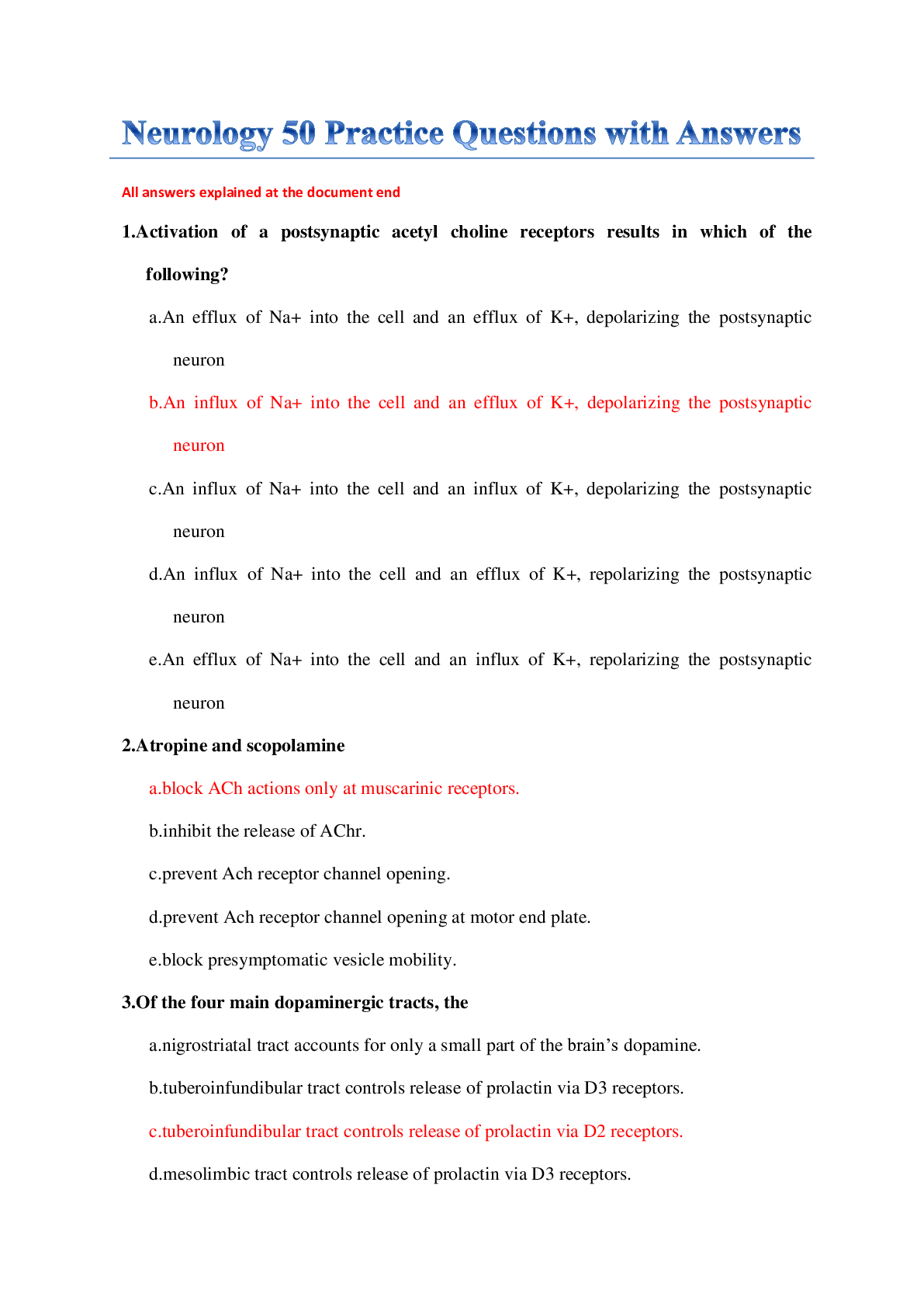
Reviews( 0 )
Document information
Connected school, study & course
About the document
Uploaded On
Apr 15, 2020
Number of pages
33
Written in
Additional information
This document has been written for:
Uploaded
Apr 15, 2020
Downloads
0
Views
62







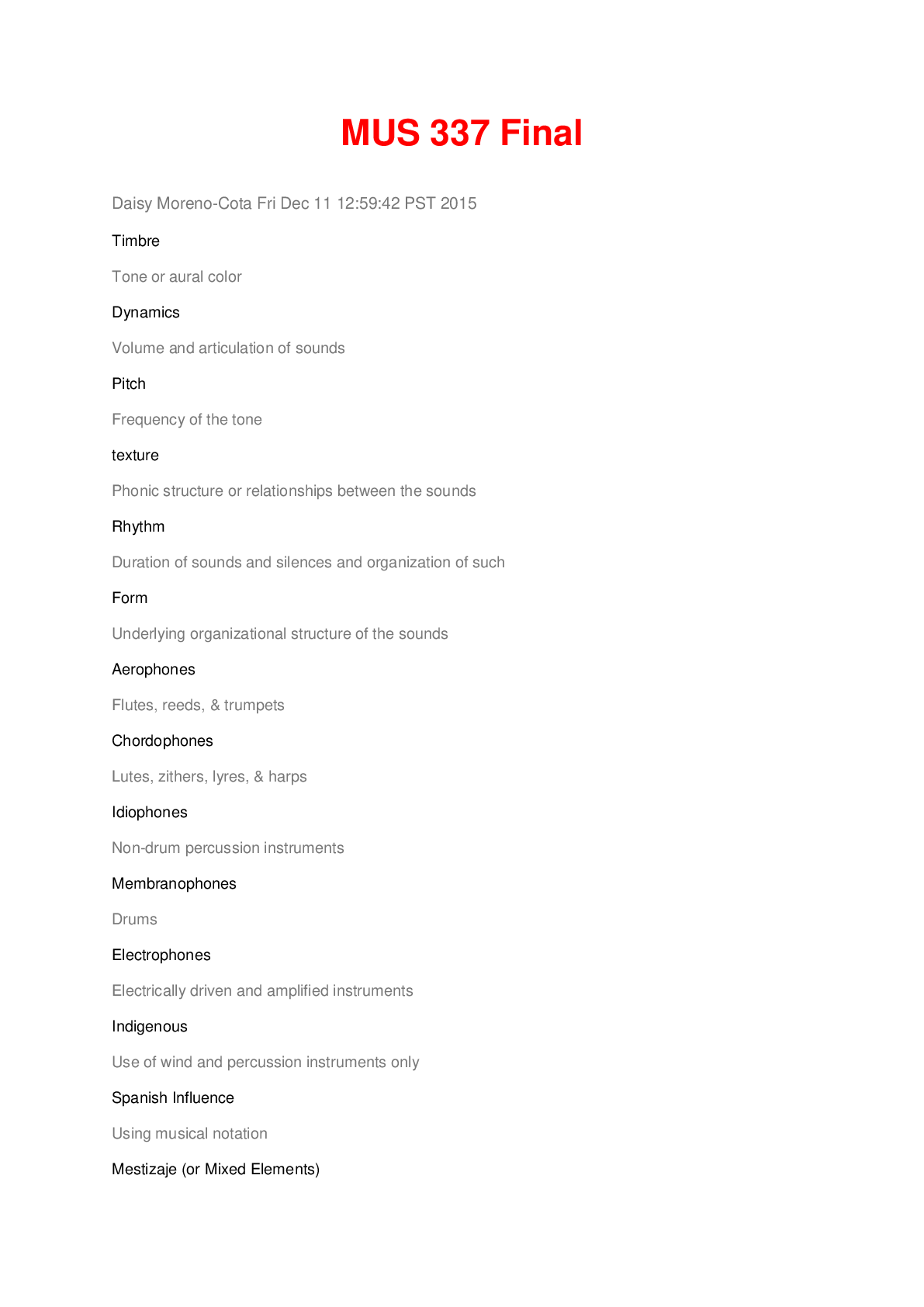




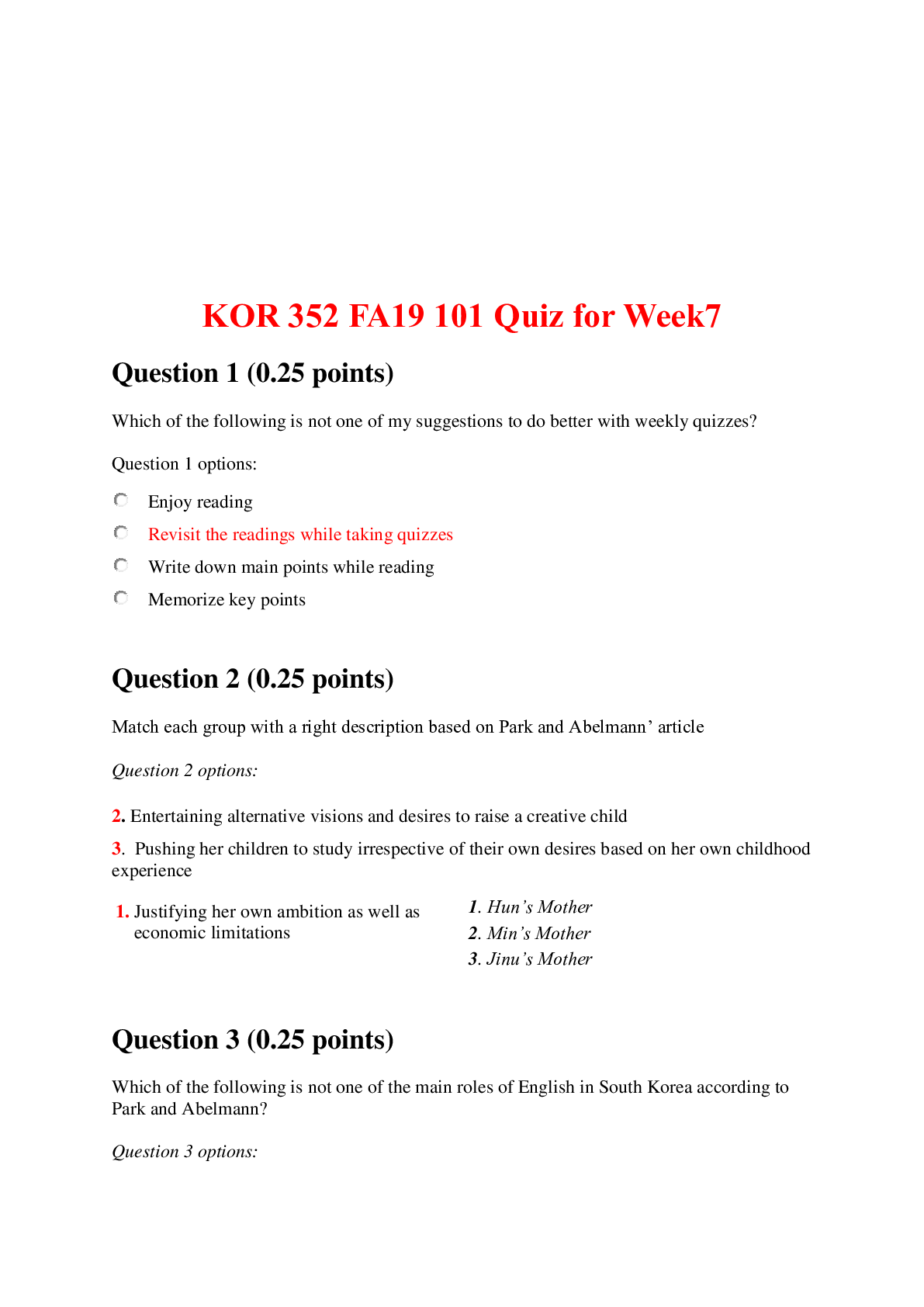


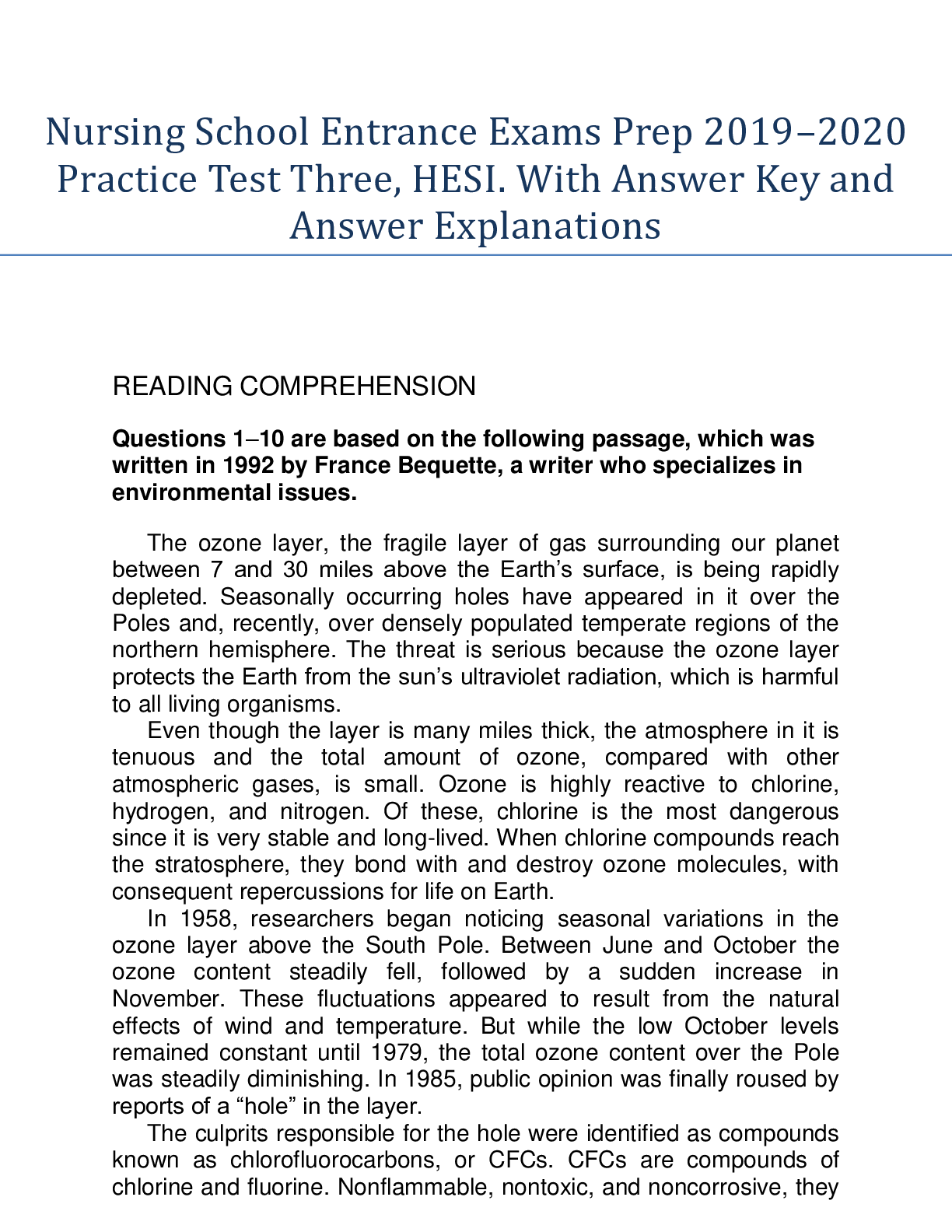
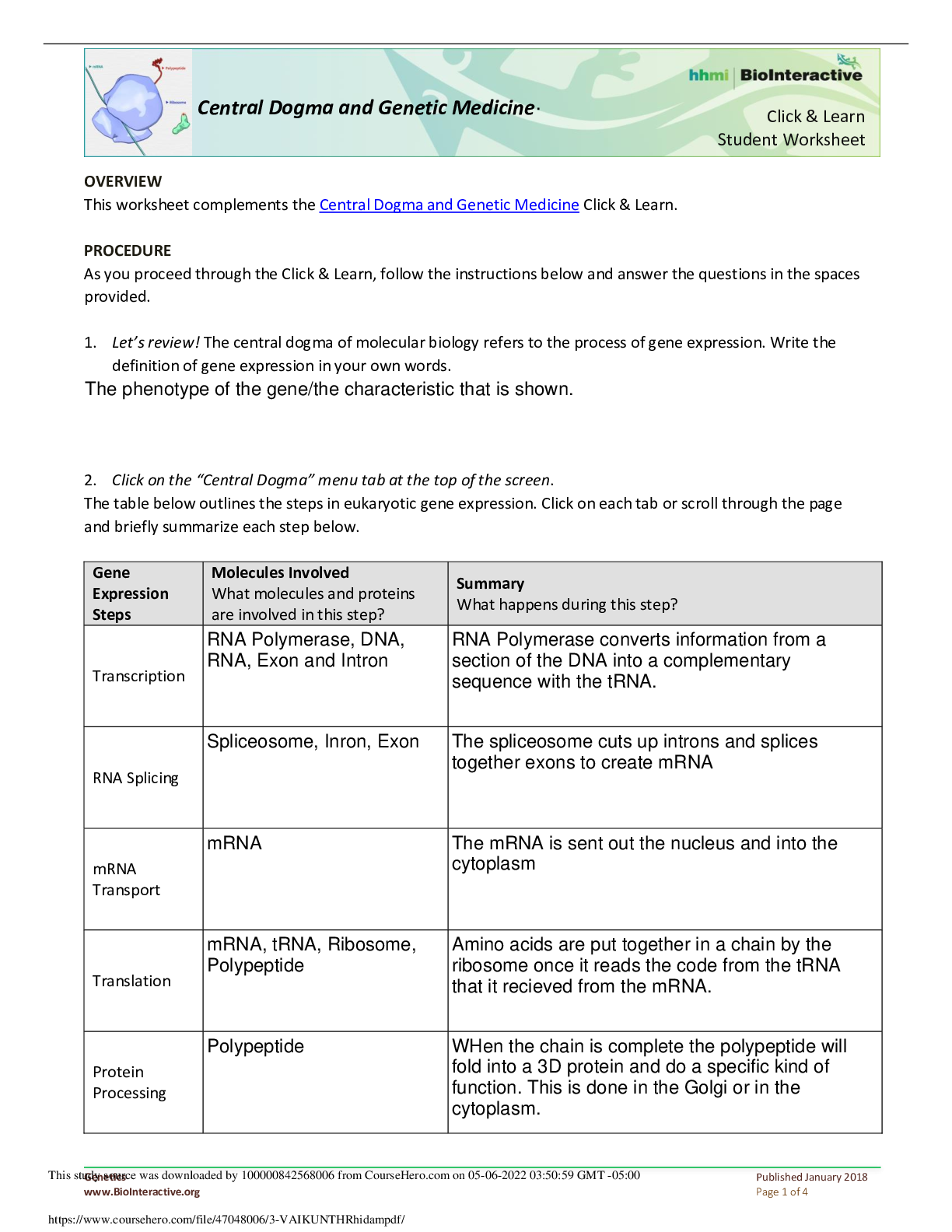
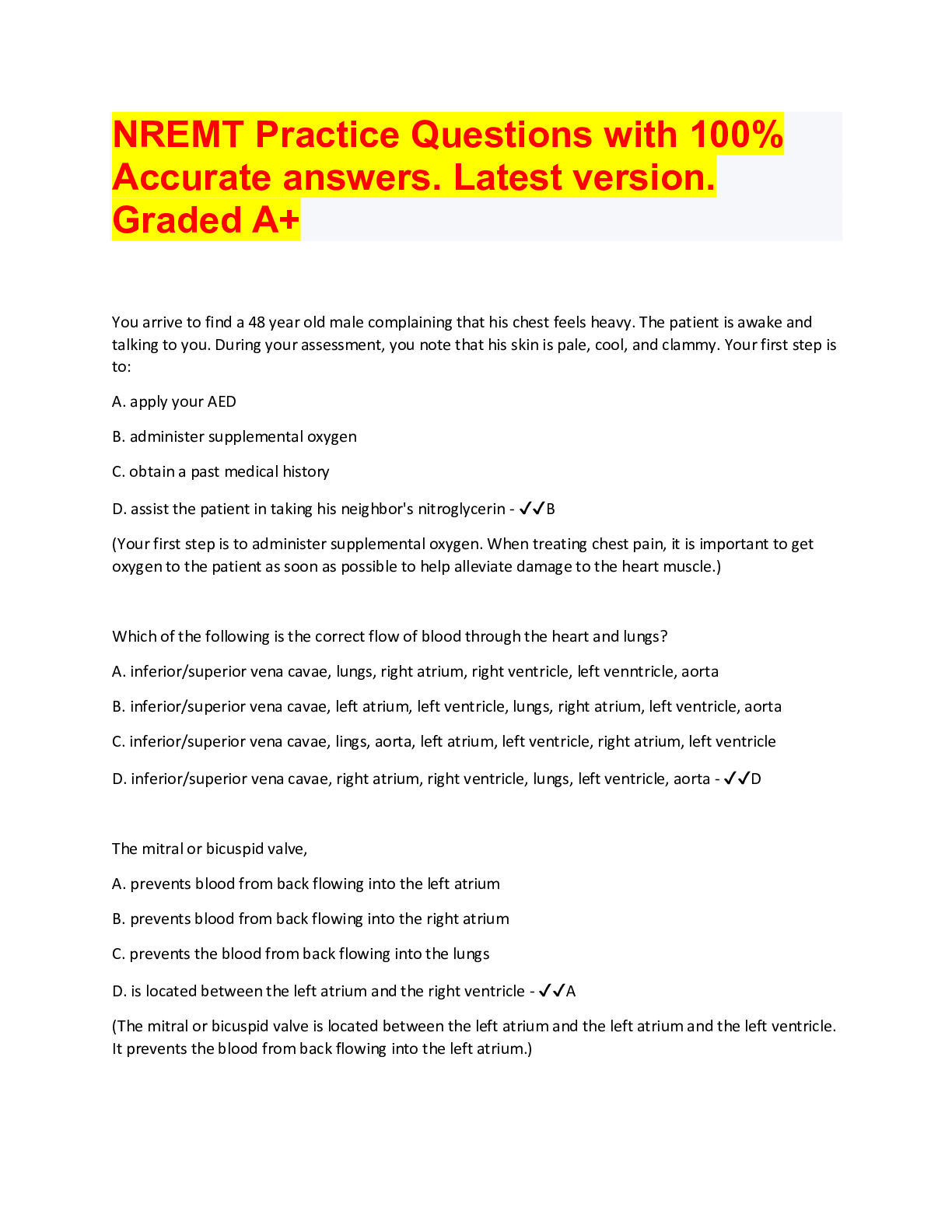
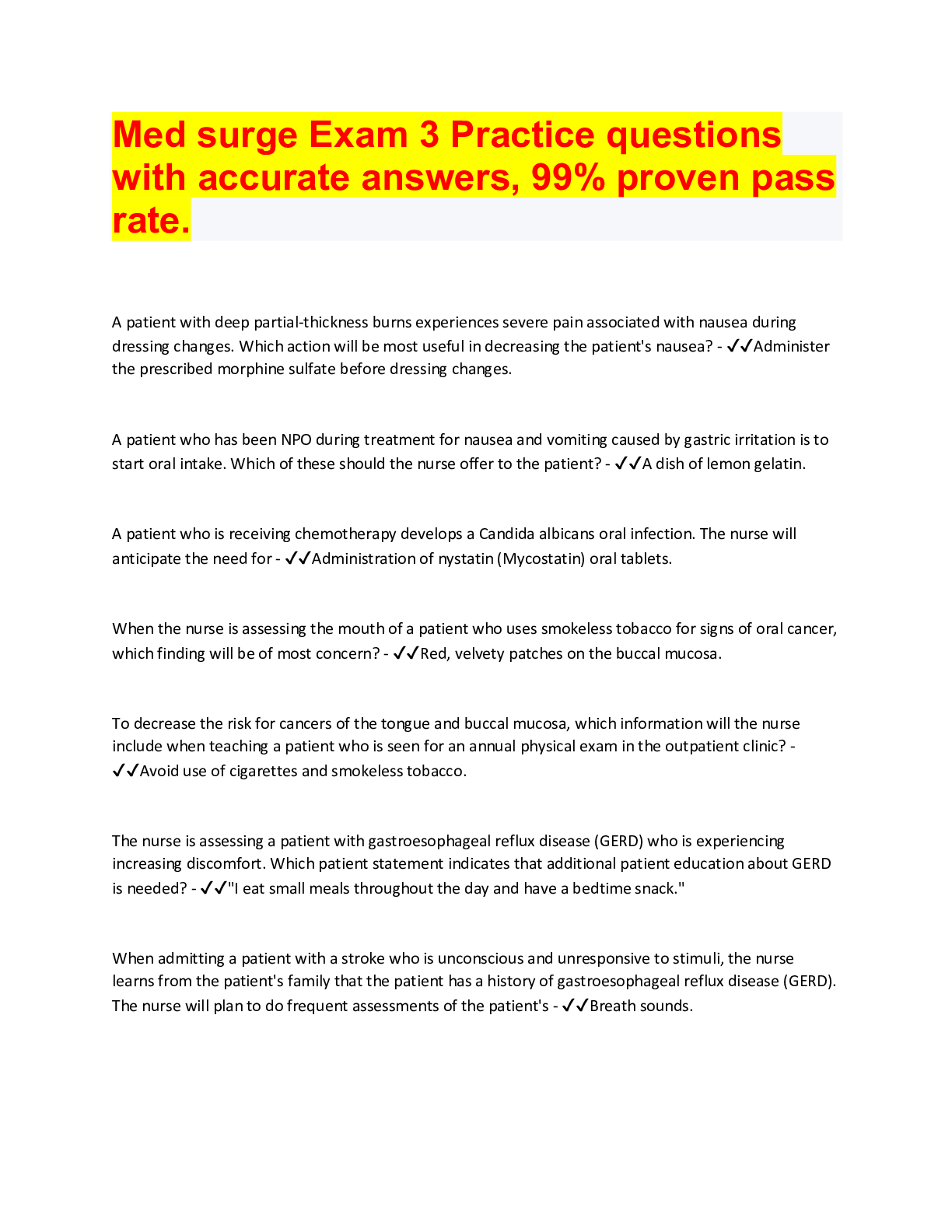
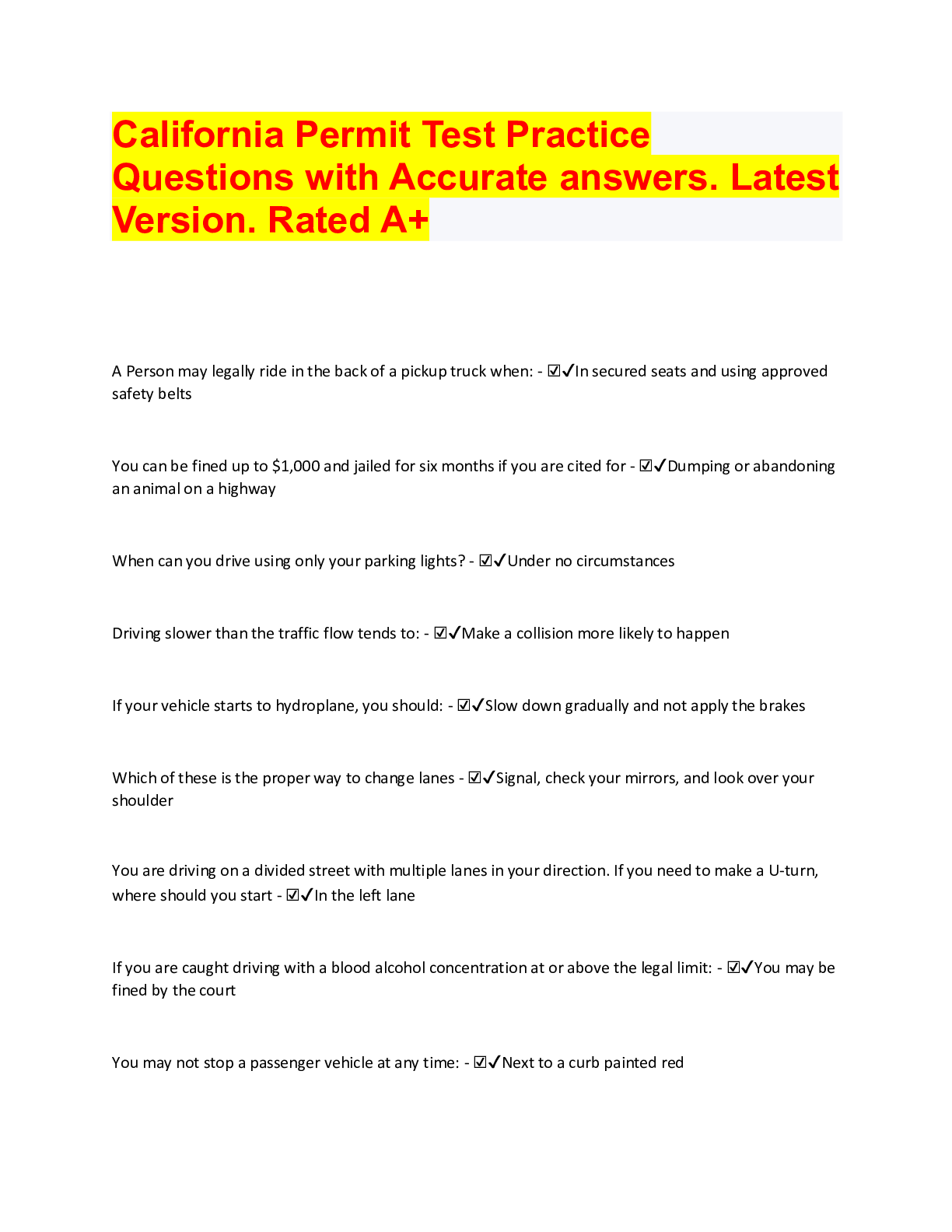
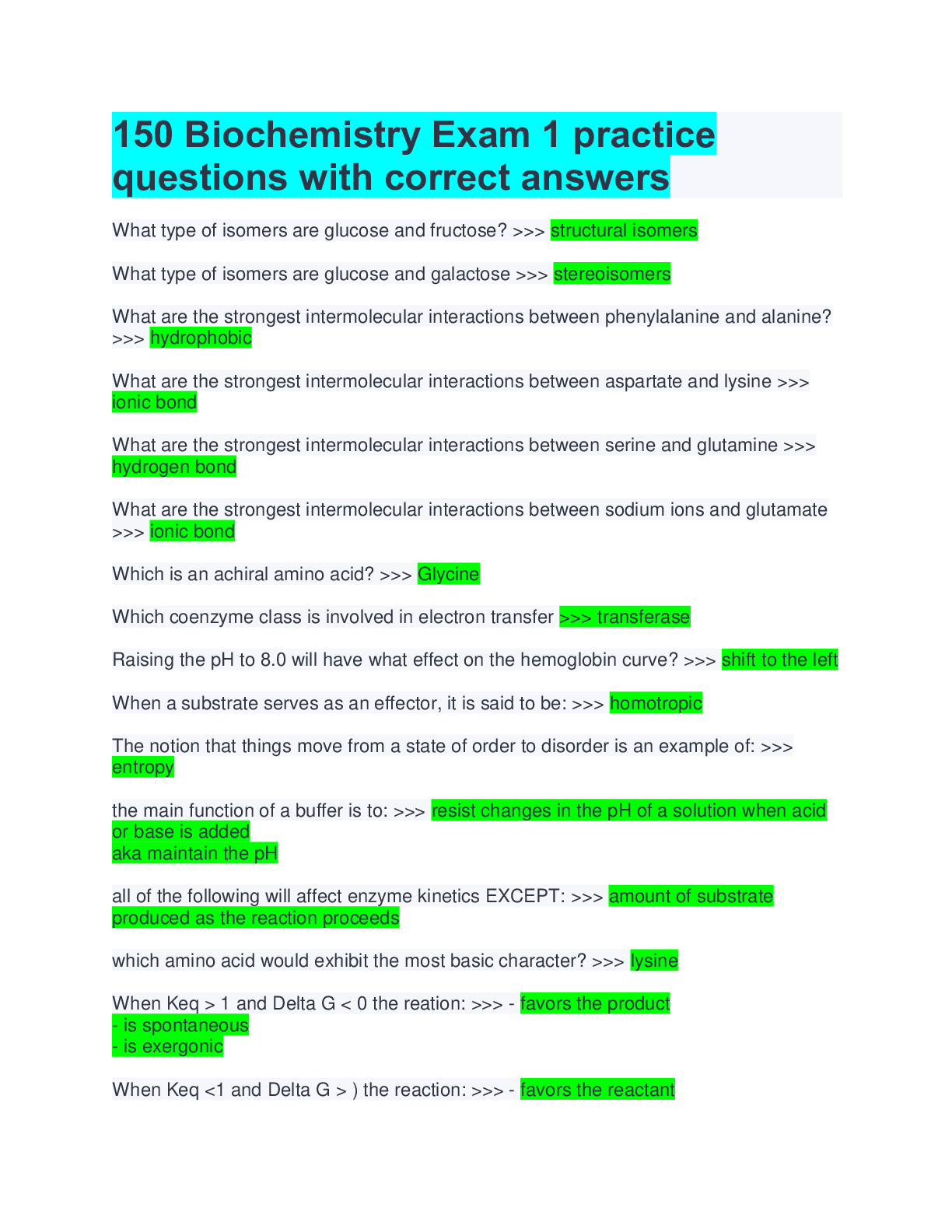
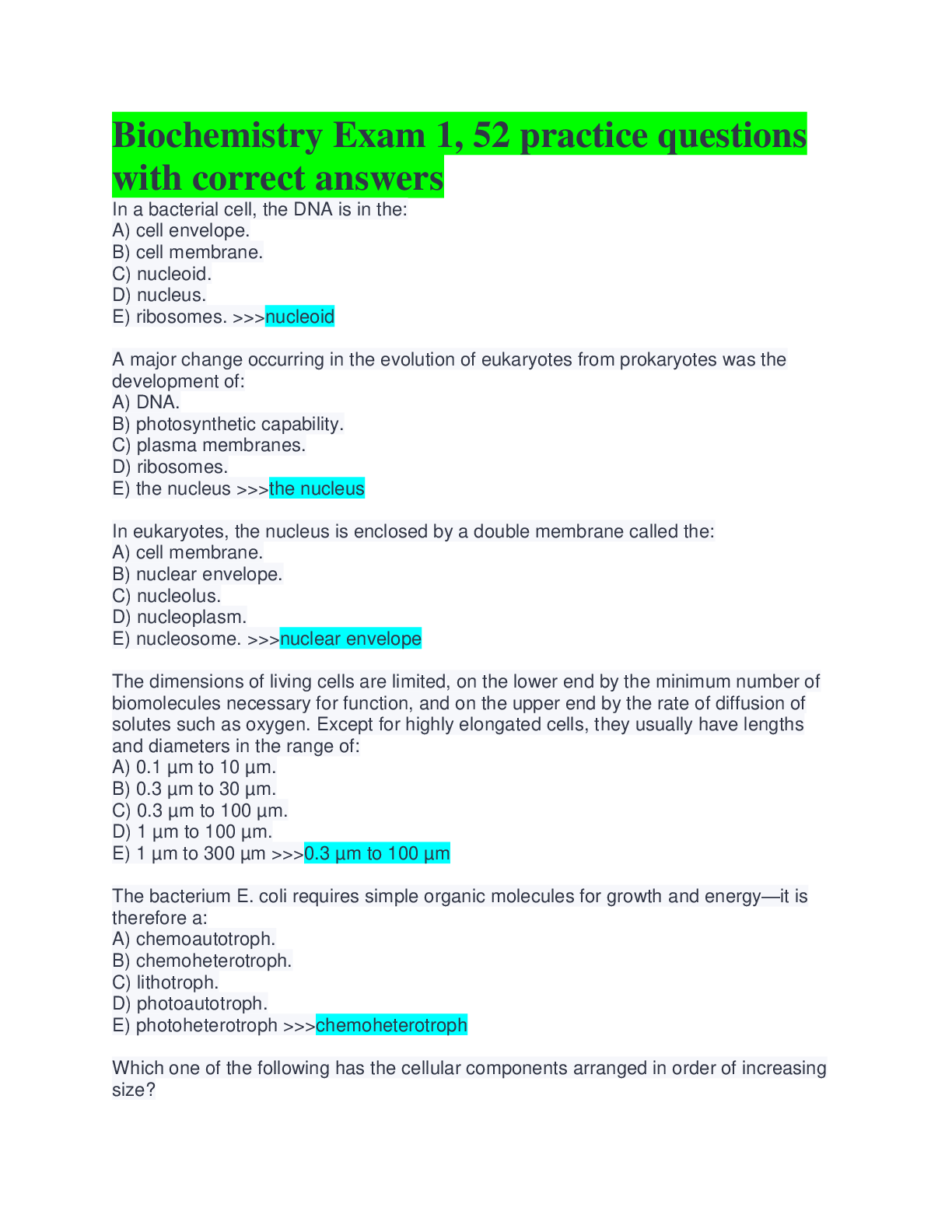

.png)
.png)
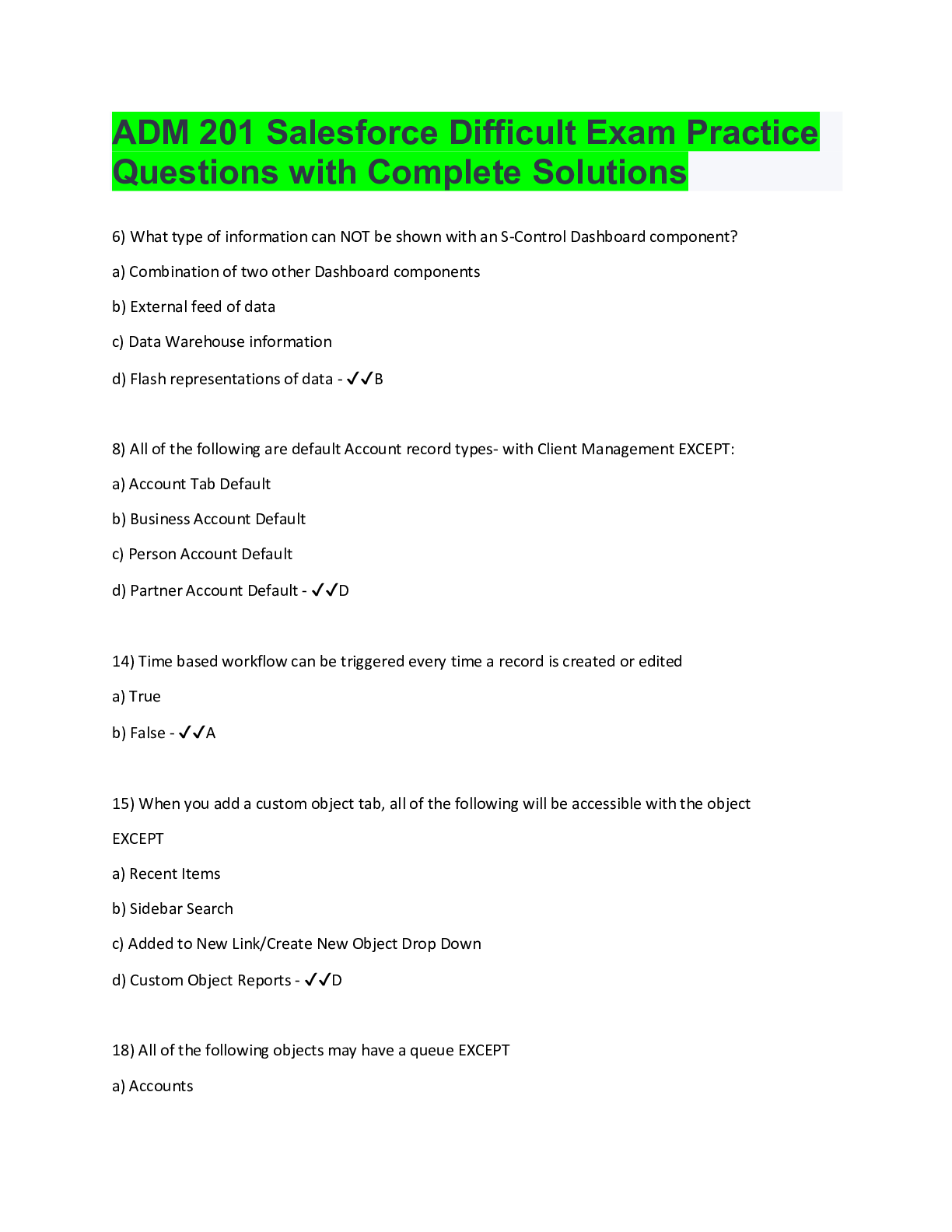
.png)
.png)




.png)
 A+ GUIDE.png)
